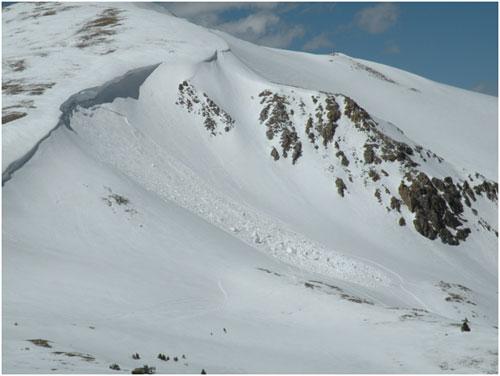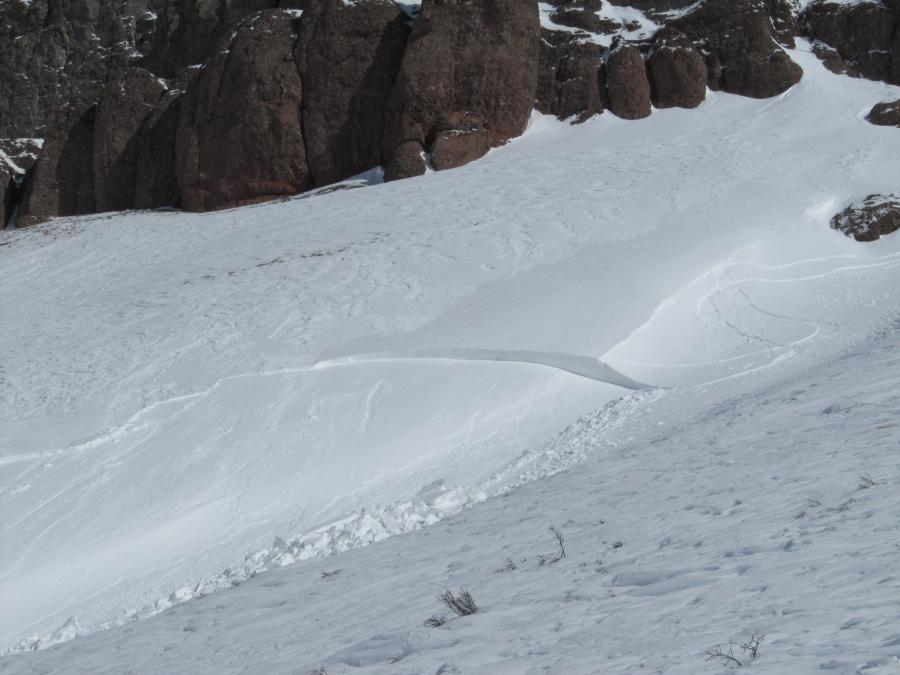Wind Slab
Release of a cohesive layer of snow (a slab) formed by the wind. Wind typically transports snow from the upwind sides of terrain features and deposits snow on the downwind side. Wind slabs are often smooth and rounded and sometimes sound hollow, and can range from soft to hard. Wind slabs that form over a persistent weak layer (surface hoar, depth hoar, or near-surface facets) may be termed Persistent Slabs or may develop into Persistent Slabs.
Wind Slabs form in specific areas, and are confined to lee and cross-loaded terrain features. They can be avoided by sticking to sheltered or wind-scoured areas.
Read about Wind Slabs in “Decision Making in Avalanche Terrain: a fieldbook for winter backcountry users”.
How They Form
Snow begins to drift when wind speeds reach about 10 mph. The wind scours snow from the windward side of terrain features such as ridges, open bowls and gullies. The snow is broken into smaller fragments and deposited on the downwind, or lee, side of the terrain features. The deposited snow can form thick, cohesive slabs. The stronger the wind the harder the Wind Slab.
Where They Are Found
Wind Slabs form in specific areas depending on the wind speed and direction. They form on the lee aspects of ridgelines, cross-loaded gullies, or other terrain features. Areas around cliff bands and the lee side of krumholtz groves can also develop Wind Slabs. At stronger wind speeds, unusual loading/deposition patterns may occur. As wind speeds increase, the Wind Slabs may form further down the slope than normally suspected, and may be found in small pockets in steep gullies or even down in the trees.
Timing
Wind Slabs are most reactive during a wind event and the first day or two after it has ended. Wind Slabs can have a longer lifespan than Storm Slabs. During periods of very cold temperatures and extended wind events, Wind Slabs can persist for around a week. Wind slabs that form over a persistent weak layer like a surface hoar, depth hoar, or near-surface facets may develop into Persistent Slabs.
Recognition
Look for convex pillows of wind-drifted snow on the lee side of ridges and other terrain features. The Wind Slab may have a chalky look and feel. Wind Slabs can be very hard, and may present a hollow drum-like sound as you traverse across the slope. Snowpack tests conducted in wind-loaded areas may reveal a Wind Slab problem in the upper few feet of the snowpack.
Treatment and Avoidance
Wind Slabs are common across Colorado. They are confined to lee and cross-loaded terrain features and can be avoided by sticking to sheltered or wind-scoured areas. Wind Slabs form in specific areas, so learning to recognize their characteristic shape and texture will help you avoid them. They usually stabilize in less than a week, so you can reduce your risk by waiting several days after a big loading event.








